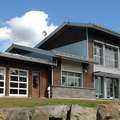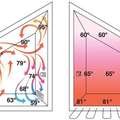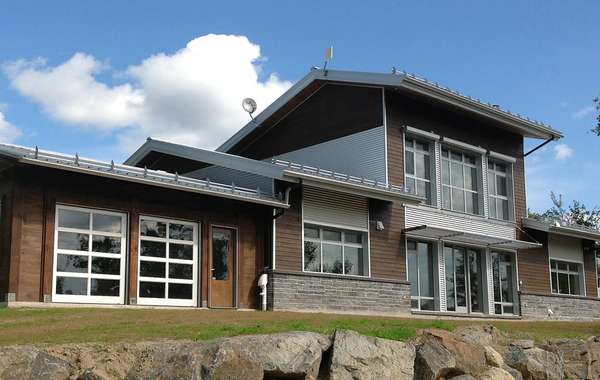Homes heated by the sun's free heat!
Passive Solar Houses are aptly named because there are no wires, panels or batteries and nothing to break down. It's just about design, and it isn't a new concept. Humans around the globe have been incorporating passive solar design features into their homes for thousands of years.
Active solar refers to any system of solar panels whether it be photovoltaic power generation, or thermal solar where liquid passing through tubes collects heat to be redistributed through your house.
According to NASA, every day the sun provides the earth with 10,000 times the total energy consumed by humans. A passive solar house is simply one that has been designed to take advantage of that.
Passive solar heating is yet another green building design feature that will save you money while improving your quality of life, EcoHome even have a design and rating system designed around it called The Passive Solar Index - check it out here. Artificial efficient energy saving lighting in the built environment affects natural human biorhythms, can lead to fatigue, and reduce our ability to concentrate - especially if the blue light content is too high.
Whether we realize it or not, we are all directly affected by the amount and quality of light we are exposed to. As most of our daylight hours are spent at work, the office environment has a particularly heavy impact on us. As a testament to the benefits of natural light, LEED certified commercial buildings that offer outside views and natural light report higher productivity and worker satisfaction.
How passive solar heating and cooling works:
There are two dates that form the cornerstone of passive solar design, December 21st and June 21st when the sun is at its highest and lowest points.
In Passive Solar design, window size and placement along with overhangs and shading are determined based on these two dates to ensure maximum exposure at midday December 21st, and maximum shading at midday June 21st in the Northern Hemisphere.
 |
|
Passive solar window design for maximum heating in winter. © Ecohome
|
These two dates are important because while you want to absorb as much heat as possible in winter, insufficient shading in summer can make houses unbearably hot and increase cooling costs, which will negate a lot of the energy savings from the free passive solar heating.
In the design phase you can determine which parts of your floors and walls will be exposed to the sun in winter, and place materials there that will absorb thermal radiation. Darker materials with heavy mass like concrete, stone or brick will absorb the most heat. For walls you can simply add a second layer of drywall (or more), if you want to keep a traditional look.
A high quality window choice is important, and to truly invest in this concept you are best to install at least triple pane gas-filled windows with low-e coatings to ensure that the heat gained in the daytime outweighs the heat lost at night - or if really wishing to Optimize window performance, consider choosing some of the latest generation suspended-film insulating-glass glazing units or windows like those from LiteZone.
It's important to keep in mind that passive solar heating is not something that should intimidate you in the design phase, and it isn't an 'all or nothing' concept. It is an ancient and relatively easy concept that has been overlooked in home construction for generations.
Now you know how to let the sun heat your house through passive solar home design. Find more pages about sustainable construction below and in the Ecohome Green Building Guide pages.
Find more about green home construction and discover the benefits of a free Ecohome Network Membership here. |



































It is interesting how passive solar is so very often overlooked.
Agreed. With a little thought in the design phase you can have lots of natural light and lower heating bills, its win win.
I am am new to this site, but I'm starting to see that there are really great topics, articles and discussions going on here. We are planning to start building our passive solar style house this spring/summer, and now since being on this site, I'm feeling inspired to revisit some of our design issues.
Hi Tim, that's always nice to hear, thanks!
If you enter 'passive solar' into the search box you'll find a lot of materials, as well as related topics on the sides of articles and at the end of every page. If you don't find what you're looking for feel free to drop a question in our advice column.
We are building our next demo house this spring (in Wakefield QC about a half hour out of Ottawa), it will be partially heated by the sun, but to try something new we will also be dedicating a portion of the south wall to solar-air panels that will feed pre-heated air into air tubes in the floor. you can see an installation video here for inspiration if you like. Best regards, Mike